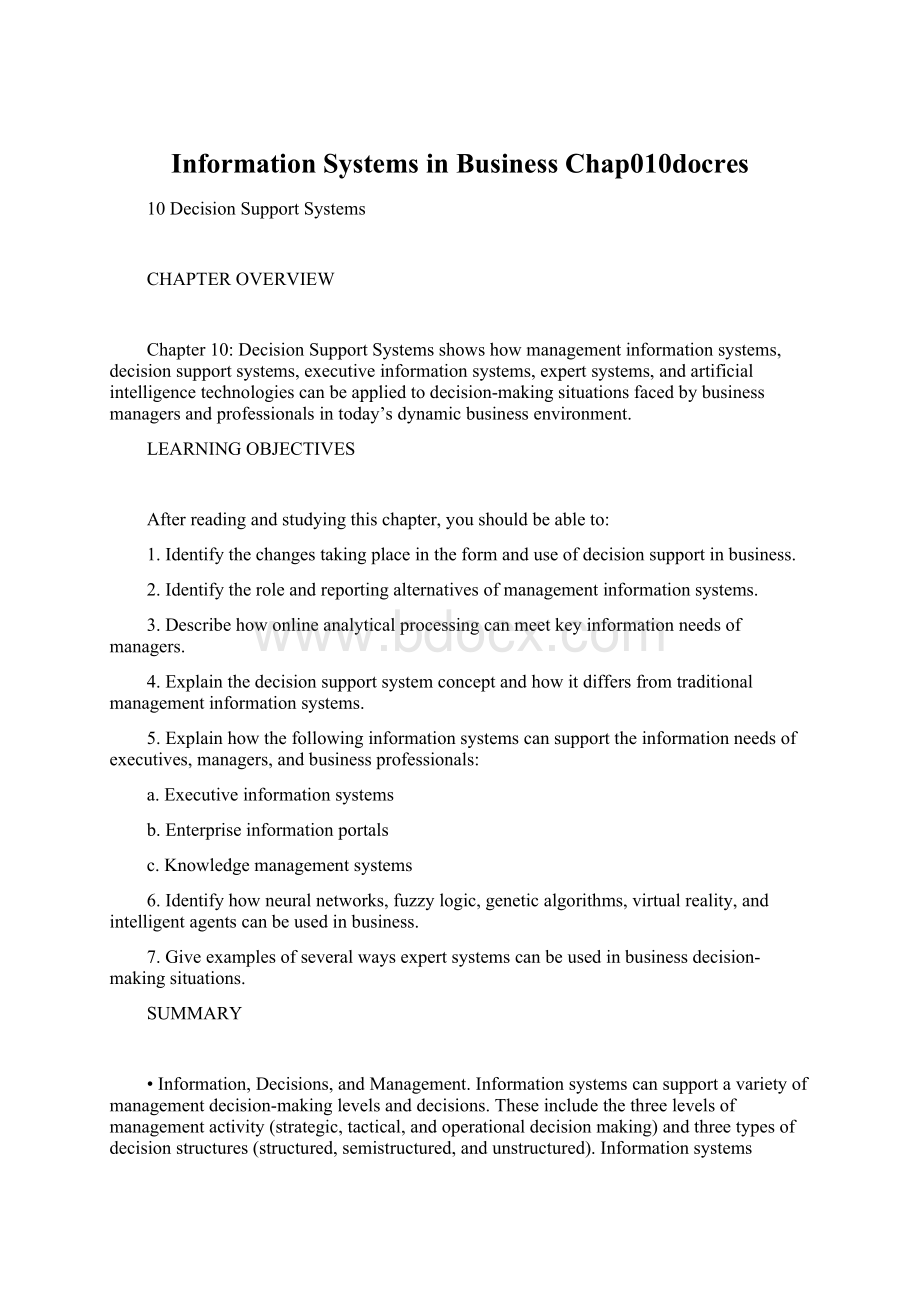Information Systems in BusinessChap010docres.docx
《Information Systems in BusinessChap010docres.docx》由会员分享,可在线阅读,更多相关《Information Systems in BusinessChap010docres.docx(20页珍藏版)》请在冰豆网上搜索。

InformationSystemsinBusinessChap010docres
10DecisionSupportSystems
CHAPTEROVERVIEW
Chapter10:
DecisionSupportSystemsshowshowmanagementinformationsystems,decisionsupportsystems,executiveinformationsystems,expertsystems,andartificialintelligencetechnologiescanbeappliedtodecision-makingsituationsfacedbybusinessmanagersandprofessionalsintoday’sdynamicbusinessenvironment.
LEARNINGOBJECTIVES
Afterreadingandstudyingthischapter,youshouldbeableto:
1.Identifythechangestakingplaceintheformanduseofdecisionsupportinbusiness.
2.Identifytheroleandreportingalternativesofmanagementinformationsystems.
3.Describehowonlineanalyticalprocessingcanmeetkeyinformationneedsofmanagers.
4.Explainthedecisionsupportsystemconceptandhowitdiffersfromtraditionalmanagementinformationsystems.
5.Explainhowthefollowinginformationsystemscansupporttheinformationneedsofexecutives,managers,andbusinessprofessionals:
a.Executiveinformationsystems
b.Enterpriseinformationportals
c.Knowledgemanagementsystems
6.Identifyhowneuralnetworks,fuzzylogic,geneticalgorithms,virtualreality,andintelligentagentscanbeusedinbusiness.
7.Giveexamplesofseveralwaysexpertsystemscanbeusedinbusinessdecision-makingsituations.
SUMMARY
•Information,Decisions,andManagement.Informationsystemscansupportavarietyofmanagementdecision-makinglevelsanddecisions.Theseincludethethreelevelsofmanagementactivity(strategic,tactical,andoperationaldecisionmaking)andthreetypesofdecisionstructures(structured,semistructured,andunstructured).Informationsystemsprovideawiderangeofinformationproductstosupportthesetypesofdecisionsatalllevelsoftheorganization.
•DecisionSupportTrends.MajorchangesaretakingplaceintraditionalMIS,DSS,andEIStoolsforprovidingtheinformation,andmodelingmanagersneedtosupporttheirdecisionmaking.Decisionsupportinbusinessischanging,drivenbyrapiddevelopmentsinend-usercomputingandnetworking;InternetandWebtechnologies;andWeb-enabledbusinessapplications.Thegrowthofcorporateintranetsandextranets,aswellastheWeb,hasacceleratedthedevelopmentof“executive-class”interfaceslikeenterpriseinformationportalsandWeb-enabledbusinessintelligencesoftwaretools,aswellastheirusebylowerlevelsofmanagementandindividualsandteamsofbusinessprofessionals.Inaddition,thegrowthofe-commerceande-businessapplicationshasexpandedtheuseofenterpriseportalsandDSStoolsbythesuppliers,customers,andotherbusinessstakeholdersofacompany.
•ManagementInformationSystems.Managementinformationsystemsprovidepre-specifiedreportsandresponsestomanagersonaperiodic,exception,demand,orpushreportingbasistomeettheirneedforinformationtosupportdecisionmaking.
•OLAPandDataMining.Onlineanalyticalprocessinginteractivelyanalyzescomplexrelationshipsamonglargeamountsofdatastoredinmultidimensionaldatabases.Datamininganalyzesthevastamountsofhistoricaldatathathavebeenpreparedforanalysisindatawarehouses.Bothtechnologiesdiscoverpatterns,trends,andexceptionconditionsinacompany’sdatathatsupportbusinessanalysisanddecisionmaking.
•DecisionSupportSystems.Decisionsupportsystemsareinteractive,computer-basedinformationsystemsthatuseDSSsoftwareandamodelbaseanddatabasetoprovideinformationtailoredtosupportsemi-structuredandunstructureddecisionsfacedbyindividualmanagers.Theyaredesignedtouseadecisionmaker’sowninsightsandjudgmentsinanadhoc,interactive,analyticalmodelingprocessleadingtoaspecificdecision.
•ExecutiveInformationSystems.Executiveinformationsystemsareinformationsystemsoriginallydesignedtosupportthestrategicinformationneedsoftopmanagement;however,theiruseisspreadingtolowerlevelsofmanagementandbusinessprofessionals.EISareeasytouseandenableexecutivestoretrieveinformationtailoredtotheirneedsandpreferences.Thus,EIScanprovideinformationaboutacompany’scriticalsuccessfactorstoexecutivestosupporttheirplanningandcontrolresponsibilities.
•EnterpriseInformationandKnowledgePortals.EnterpriseinformationportalsprovideacustomizedandpersonalizedWeb-basedinterfaceforcorporateintranetstogivetheiruserseasyaccesstoavarietyofinternalandexternalbusinessapplications,databases,andinformationservicesthataretailoredtotheirindividualpreferencesandinformationneeds.Thus,anEIPcansupplypersonalizedWeb-enabledinformation,knowledge,anddecisionsupporttoexecutives,managers,andbusinessprofessionals,aswellastocustomers,suppliers,andotherbusinesspartners.AnenterpriseknowledgeportalisacorporateintranetportalthatextendstheuseofanEIPtoincludeknowledgemanagementfunctionsandknowledgebaseresourcessothatitbecomesamajorformofknowledgemanagementsystemforacompany.
•ArtificialIntelligence.Themajorapplicationdomainsofartificialintelligence(AI)includeavarietyofapplicationsincognitivescience,robotics,andnaturalinterfaces.ThegoalofAIisthedevelopmentofcomputerfunctionsnormallyassociatedwithhumanphysicalandmentalcapabilities,suchasrobotsthatsee,hear,talk,feel,andmove,andsoftwarecapableofreasoning,learning,andproblemsolving.Thus,AIisbeingappliedtomanyapplicationsinbusinessoperationsandmanagerialdecisionmaking,aswellasinmanyotherfields.
•AITechnologies.ThemanyapplicationareasofAIaresummarizedinFigure10.26,includingneuralnetworks,fuzzylogic,geneticalgorithms,virtualreality,andintelligentagents.Neuralnetsarehardwareorsoftwaresystemsbasedonsimplemodelsofthebrain’sneuronstructurethatcanlearntorecognizepatternsindata.Fuzzylogicsystemsuserulesofapproximatereasoningtosolveproblemswhendataareincompleteorambiguous.Geneticalgorithmsuseselection,randomizing,andothermathematicfunctionstosimulateanevolutionaryprocessthatcanyieldincreasinglybettersolutionstoproblems.Virtualrealitysystemsaremultisensorysystemsthatenablehumanuserstoexperiencecomputer-simulatedenvironmentsasiftheyactuallyexisted.Intelligentagentsareknowledge-basedsoftwaresurrogatesforauserorprocessintheaccomplishmentofselectedtasks.
•ExpertSystems.Expertsystemsareknowledge-basedinformationsystemsthatusesoftwareandaknowledgebaseaboutaspecific,complexapplicationareatoactasexpertconsultantstousersinmanybusinessandtechnicalapplications.Softwareincludesaninferenceengineprogramthatmakesinferencesbasedonthefactsandrulesstoredintheknowledgebase.Aknowledgebaseconsistsoffactsaboutaspecificsubjectareaandheuristics(rulesofthumb)thatexpressthereasoningproceduresofanexpert.Thebenefitsofexpertsystems(suchaspreservationandreplicationofexpertise)mustbebalancedwiththeirlimitedapplicabilityinmanyproblemsituations.
KEYTERMSANDCONCEPTS
1.AnalyticalModelling(395):
Interactiveuseofcomputer-basedmathematicalmodelstoexploredecisionalternativesusingwhat-ifanalysis,sensitivityanalysis,goal-seekinganalysis,andoptimizationanalysis.
a.Goal-SeekingAnalysis(396):
Makingrepeatedchangestoselectedvariablesuntilachosenvariablereachesatargetvalue.
b.OptimizationAnalysis(396):
Findinganoptimumvalueforselectedvariablesinamathematicalmodel,givencertainconstraints.
c.SensitivityAnalysis(395):
Observinghowrepeatedchangestoasinglevariableaffectsothervariablesinamathematicalmodel.
d.What-ifAnalysis(395):
Observinghowchangestoselectedvariablesaffectothervariablesinamathematicalmodel.
2.ArtificialIntelligence(405):
Thesimulationofhumanthoughtprocesses.
3.BusinessIntelligence(383):
Atermprimarilyusedinindustrythatincorporatesarangeofanalyticalanddecisionsupportapplicationsinbusinessincludingdatamining,decisionsupportsystems,knowledgemanagementsystems,andonlineanalyticalprocessing.
4.DataMining(397):
Usingspecial-purposesoftwaretoanalyzedatafromadatawarehousetofindhiddenpatternsandtrends.
5.DataVisualizationSystems(392):
Systemsthatrepresentcomplexdatausinginteractivethree-dimensionalgraphicalformssuchascharts,graphs,andmaps.Thesetoolshelpuserstointeractivelysort,subdivide,combine,andorganizedatawhileitisinitsgraphicalform.
6.DecisionStructure(382):
Informationsystemsthatsupportavarietyofmanagementlevelsanddecisions.Theseincludethethreelevelsofmanagementactivity(strategic,tactical,andoperational),andthreetypesofdecisionstructures(structured,semi-structured,andunstructured).
7.DecisionSupportSystem(384):
Aninformationsystemthatutilizeslogicmodels,adatabase,andadecisionmaker’sowninsightsinanad-hoc,interactiveanalyticalmodellingprocesstohelpsupportdecisionmaking.
8.EnterpriseInformationPortal(401):
Provideweb-enabledaccesstodatabasesanddecisionsupporttoexecutives,managers,employees,suppliers,customers,andotherbusinesspartnersviaasingle,customizableinterface.
9.EnterpriseKnowledgePortal(403):
Providesuserswithaccesstoenterpriseknowledgebasesthroughasingle,customizableinterface.
10.ExecutiveInformationSystem(399):
Aninformationsystemthatprovidesstrategiclevelinformationtailoredtotheneedsoftopmanagement.
11.ExpertSystem(411):
Acomputer-basedinformationsystemthatusesacomplexrulesettoprocessinformationandactasaconsult